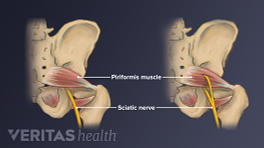Sciatica is when a patient is suffering from impingement or pressure on a nerve which causes pain to go down the extremity, oftentimes to the foot. Could be caused by herniated disc, could be caused by spinal stenosis, which is a tightening of the spinal canal, it could be caused by a spondylolisthesis, which is a slip of one vertebra on another. Or pretty much anything that puts pressure on a nerve that causes pain down the leg.
One treats the initial onset of sciatica conservatively, and by that I mean simple things such as ice for the first twenty-four to forty-eight hours, the cold helping with some of the pain, heat thereafter, for the next forty-eight hours perhaps. Increasing the circulation to the area, getting away some of the matabolites. In addition to which, we often use certain over-the-counter medications which include things like Tylenol®, Advil®, or Aleve®.
We do not believe in bed rest for more than twenty-four, maximum forty-eight hours. Certain amount of exercise is necessary.
Exercise should be non-weight bearing, such as a stationary bicycle or a swimming pool - something that doesn't put excess stress on the affected area. Occasionally surgery is necessary. Prior to surgery, one must make a definitive diagnosis, however, of what is going on - and this often will require an MRI scan, a myelogram, or a myelogram followed by a CT scan. Initially, if there isn't a dangerous problem occurring, one will consider what's called an epidural steroid injection or a selective nerve root block, both of which you can learn more about from other parts of Spine dash health.











